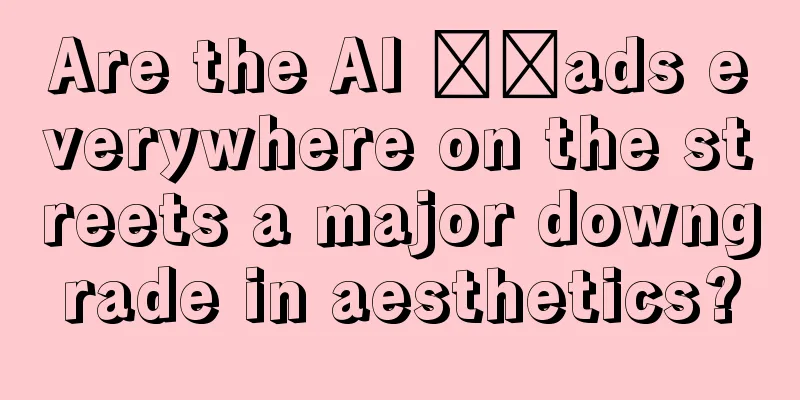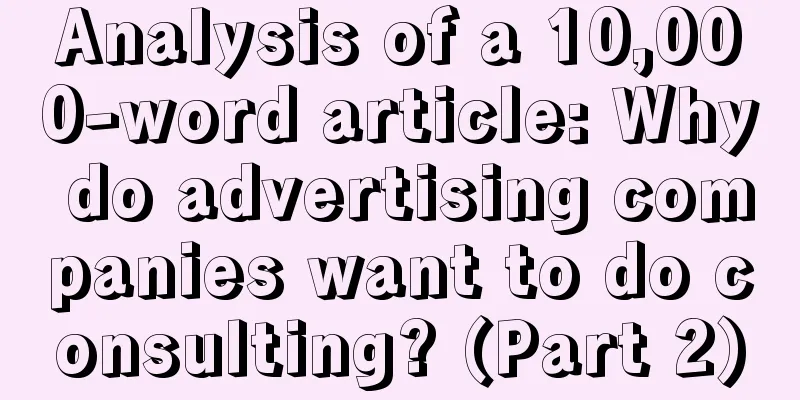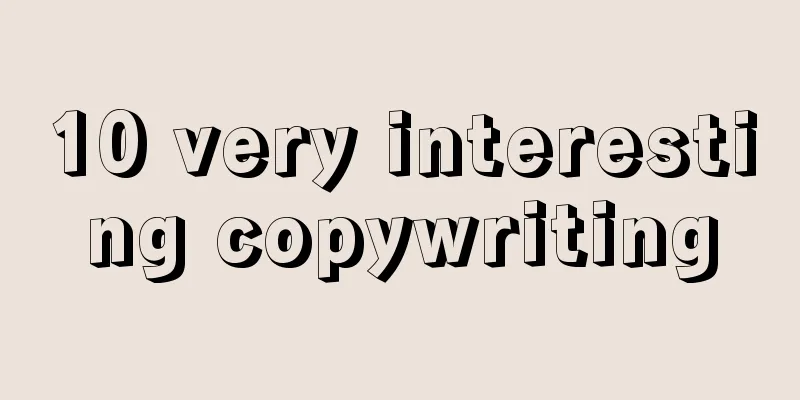Are the AI ads everywhere on the streets a major downgrade in aesthetics?

Over the past year, AI has gradually become common and everyday. As the giants are competing with each other to release new products, AI has also appeared in more inconspicuous places, such as subways, elevators, product posters, and software opening screens, passing by ordinary people online and offline. However, the effects are often hard to describe and can even become a mental attack. 1. Do these "conspicuous bag" ads make you feel uncanny?Imagine that one morning, you might pick up your security-checked backpack with sleepy eyes, mechanically scan the code or swipe the card, and drag your heavy body through the crowded crowd. At the moment of distraction, you turned your head and saw a shining billboard with a public service advertisement on it. The theme was "Your Appearance", paying tribute to everyone working hard at their job. Taking a closer look, you feel something is wrong. This Pixar-style girl has unnatural hands and the number of fingers is also problematic. More importantly, she doesn't have a "class vibe" and has nothing in common with the image of a working person. This set of advertisements is real and comes from Shenzhen Metro. It is officially stamped as created by AI. They also have a set of advertisements that focus on sports style, also represented by cute cartoon characters. One of the little boys has a bicycle without a seat. Although he looks relaxed, his local physical condition is very worrying. So, is it more "real" and more immersive to let AI generate real people? Not necessarily, it may be counterproductive and evoke the uncanny valley effect of being neither human nor inhuman. Advanced elevator advertisements all believe in one truth - AI that loves to smile will have good luck. The original intention of JD.com’s Double 11 advertisement may have been to project the sense of happiness of returning home with a full load and to entice consumers to spend money, but the effect was somewhat strange. The skinny woman with anti-gravity hair opened her mouth wide, her eyes were dull, but her mental state was crazy. The fake smile arc of the family of three was almost exactly the same. Under the soft light filter, they looked like copy-and-pasted puppets or solidified wax figures. This may be the AI's understanding of "If you are not from the same family, you will not enter the same door." Images from: Xiaohongshu @司不二兰, @言吾waku In comparison, Alipay's elevator advertisement is relatively normal. It clearly states AIGC from the start. Sisters gather around a stove to enjoy hotpot, or brothers drink wine and chat. Except for the fact that the food looks a bit shabby and the characters look a bit greasy and plastic, there is a festive atmosphere. Image from: Xiaohongshu @Love Cd If AI is specifically used to represent a certain object, it can also make new jokes and even open up new ideas for Chinese horror. The boy's pasta eating skills are similar to those of AI Will Smith, and the noodles and lips are inseparable. The little cyber girl who endorses toothpaste should not have any worries about cavities. Her eyes are scary big, and her skin is smooth without any texture, like a doll made of porcelain. Images from: Xiaohongshu @rataalada, @摸头姐姐 It’s okay for the AI beauty to label milk as youthful, but compared to the real-life advertisement in Japan many years ago, which had a 99.99% duplication rate, and whose movements, hairstyles, colors and even bubble elements were similar, it’s a bit of an imitation. Games have not escaped the invasion of AI. Paper people are openly shouting in the circle of friends, but they forget that the more abdominal muscles are not necessarily better. It is difficult for real people to train eight pack, and ten pack is no problem for AI. However, they fail to take aesthetics into consideration, like corn that has become a spirit. A shirt that disappears into the skin is worse than not being worn. In short, it cannot attract players to click on the "tease", and they just want the monsters to retreat quickly. These ads are clearly intended to promote products, but they lack empathy and persuasiveness, and the details that make people feel like they are in the uncanny valley are all very similar. Besides being weird, they also give people the feeling of saving money to the last drop of cash. If we break away from the stereotypes of characters, AI can always play a placebo role in terms of styling, which is better than nothing. The "What to do this May Day" series of posters released by Fliggy at subway stations show the scenery of different countries and themes through the eyes of AI. It's okay if you look at one of them alone, and the idea echoes the slogan, but the style is not unified and there is no recognition, making it difficult to remember. It's even hard to tell that it's the same set of advertisements. It's more like a draft that has a concept but is not grounded enough. Despite being so harsh for so long, we have to admit that many people don’t look at advertisements carefully. AI advertising can achieve “large quantity and sufficient quantity”, and in less sophisticated business scenarios, there is no need to be picky about details. Often the budget is more important than aesthetics, and the fastest and most cost-effective way is the best. Compared to the uncanny valley effect that is coming, AI replaced models, studio photography, costumes and props in a few seconds, and mass-produced more fast-food "art", which may be a more terrifying thing. To paraphrase the line in "Sherlock Holmes", AI has lowered the aesthetic taste of the entire street. The upper limit of human imagination may determine the performance of AI. In fact, many AI ads look scary and boring. The problem is not with AI, but that there is no idea behind the products, let alone impressing people and making them want to spend money. This only shows that AI is used for the sake of AI, with poor aesthetics and a love of following trends. On the contrary, some AI advertisements that have little technical content but outstanding creativity can be talked about a lot. Last year, when OpenAI was just killing it, it became a popular trend to endorse ChatGPT. McDonald's and Burger King also continued to use ChatGPT to love and hate each other. McDonald's asked "What is the most iconic burger in the world?" ChatGPT said "Big Mac." The local Burger King was not to be outdone and asked ChatGPT "What is the largest burger in the world?" The answer was "Royal Burger." The complete answers of the two brands were made into station posters and placed side by side. The prompt words are very important, and the AI's answers can also be guided manually. No one really cares what the specific answers are, but when McDonald's and Burger King, the "old enemies" who have been engaged in an advertising war for decades, use AI to talk to each other again, it itself is quite a show effect. These two advertisements have the buff of brand history. IKEA Taiwan, which has been popular for its advertisements many times, once again demonstrated its creativity and launched AI posters based on fairy tales. With an alarm clock, Cinderella can rush back from the ball before the 12:00 DDL. We are smart but still can't see the king's new clothes, but we can buy the same laundry bag. Although the painting style is still a bit strange, the combination of fairy tales and daily life establishes alternative associations and can still convey the fun of life. Going against the mainstream voice that praises AI and desperately marketing the inferiority and unreality of AI is also a good strategy. The audience may think like the routine in the domineering president novel: Damn it, you successfully caught my attention. BodyArmor, a sports drink brand under Coca-Cola, used AI as a stepping stone for its products during the Super Bowl in February this year. This ad, called "Field of Fake," used a technique of first suppressing and then praising. The first half was deliberately crudely produced by AI, with the athletes' bodies deformed and their facial features flying around. When they drank the beverage, their mouths would stick to the bottle mouth. The second half was a real shot, emphasizing the authenticity of the product's ingredients, taste, and efficacy. Although the ideas vary, these ads all retain real emotions and intriguing parts based on AI, which is in line with Apple’s most famous slogan "Think Different". In contrast, the negative examples only use AI as a means of cutting corners. Perhaps at the beginning they can arouse some kind of "surrealist" curiosity, similar to Sora's failed work. But after seeing so much of it online and offline, the garbled words, empty eyes, disproportionate human bodies, illogical lighting and shadows, and blurred backgrounds only make people feel boring and creepy. A pizza commercial that's as scary as AI Will Smith eating noodles. There is no doubt that AI is advancing at a fast pace, and many "fake at first glance" bugs may soon disappear, but at least at this stage, simple and crude AI advertising cannot capture the subtle emotions of human beings. This is almost an inexplicable intuition. We know that those things are not real and have no "soul", but we can't necessarily list one, two, three, four reasons. When scrolling through the information streams on social media platforms such as Xiaohongshu, the most common comments I saw about AI ads were "incomprehensible" - "I can't even tell what it is at first glance", "I don't know what it's saying", and "What's the point of advertising if humans can't resonate with it." This may be contrary to the rhetoric that AI technology companies like to use. In their words, everyone can be an artist, and even if they have not been influenced by art, they can generate works that consume half of the history of art by inputting prompts. But whether the things made by AI are good or perfunctory is still judged by people, and people will vote with their intuition. 2. Since we will eventually arriveNo matter how many problems AI advertising has, its prevalence itself illustrates an unspoken secret among people: this torrent cannot be stopped. Last September, Japanese beverage brand Ito En used an AI woman in a 15-second advertisement. It was not easy to tell whether she was real or fake at a glance. She looked like an amateur model whose face the audience would not deliberately remember. Netizens exclaimed: "I can't tell it's AI, but it looks like over-smoothing." "It's definitely not like the AI I usually see, otherwise it would look cheap." Even better, after taking a sip of tea, the AI woman returned from the future to the present, and the creative idea of the advertisement was closely linked to AI: the time to change the future is now. Soon, AI will be able to more easily create actors of any age, gender or body type without worrying about the risk of collapse. "Will AI take away jobs for real people?" "How will AI affect copyright?" are questions that naturally come to mind every time I see such advertisements, and they are also discussed by TV stations. In fact, in addition to occupying the big screen and challenging real people, AI has also been shining quietly under the iceberg of little-known things. Those who feel this more clearly are the merchants who sell goods, as well as the creators who are anxious about AI, crazy about AI, and banging their heads against the wall because of AI. AI no longer appears as some obvious, bad, greasy style, but as a silent servant hidden among the crowd. Last November, Google launched a generative AI service for advertisers. One of its features is that if a merchant already has footage of a model holding a product, then the background can be changed at will so that the advertisement can be used in different holidays and seasons. These pictures are inconspicuous, but they win in quantity. At about the same time, Amazon also launched a similar feature. Advertisers who are not good at creative expression only need to select the product and click "Generate". Amazon will use generative AI to provide a set of images that are more down-to-earth and closer to daily life based on product details within a few seconds. Advertisers can also refine the images by entering short text prompts. In the past, some advertisers might have placed products like toasters on a white background. The most high-end kitchen appliances often only need the most simple exposure. But Amazon found that when the same toaster was placed next to croissants on the kitchen counter, the click-through rate could be 40% higher. To some extent, AI allows laymen without professional skills to get started in e-commerce photography. Amazon, which used to pay more attention to advertising data analysis and delivery efficiency, put forward an interesting point of view: "Advertising is half art and half science, and the art part will become easier. My colleagues in the video team have similar views. The way they use AI is like using interns and calling up a huge library of materials at the same time. The generative filling of PS is suitable for setting up scenes on the spot, which not only saves props costs, but also saves time for on-site shooting. I wonder if you can see that the ornaments under the TV are all generated by AI? The colleague who contributed the materials sighed: "It's so simple that I almost spoiled myself. I have forgotten the PS skills I learned before. The graphic tool DALL·E in ChatGPT is suitable for generating pictures and making some references for shooting scenes. The time saved can be used to better think about and polish the storyboard script. If you ask them what experience they can impart, it is that vision and aesthetics are more important. Let tools become tools and people become better people. The best time to learn to use AI tools was six months ago, and the second best time is now. It is conceivable that in the future AI will become increasingly common and fall into daily life, and it will no longer be recognizable at a glance, like a drop of water falling into the sea, and no one will be able to deliberately distinguish between the drop of water and the sea. If we say that AI ads lack personality and emotion, perhaps we need to further reflect on how many human ads are impressive, and how to retain the power to move people while empowering AI. Author: Zhang Chengchen Source: WeChat public account "Ifanr (ID: ifanr)" |
<<: Taobao Live can no longer sit still as it becomes an MCN
>>: Who will benefit if Taobao gets involved in MCN?
Recommend
Breaking the dimensional wall, "Barbie" becomes the new traffic code
Barbie will conduct joint marketing and promotion ...
Can Amazon communicate with sellers? What are the requirements for opening a store on Amazon?
After shopping on the Amazon platform, if we have ...
How can Amazon images be copyrighted? How to prove the copyright of images?
E-commerce platforms still attach great importance...
Where can I find Amazon disposal fees? How are they calculated?
Merchants who open stores on Amazon know that ther...
How does Amazon modify payment methods? What are the payment methods?
Now more and more buyers in China are shopping on ...
Yesterday, Station B decided to cancel the display of playback volume
Some time ago, the news that B station cancelled t...
It is so inconvenient to fold the service account messages. How to move them out? More than 4,000 words to explain it all at once!
Recently, when using WeChat, you can clearly feel ...
ChatGPT becomes popular, how will artificial intelligence empower marketing?
Recently, ChatGPT has set off a new wave of enthus...
Super anchor's trust game
With the rise of the e-commerce industry, super an...
Brands use "cute marketing" to conquer young people
"Cute and fun marketing" has been widely...
Do you have any misunderstandings about the rules and logic of Tik Tok?
This article is very long and it is not easy to fi...
The underlying logic of the growth of Xiaohongshu brands and bloggers - categories
Introduction: Through the analysis of past experie...
Does Amazon's third-party payment platform charge fees? What are the rates?
Everyone on Amazon is doing cross-border e-commerc...
Is the PayPal fee high? How is the fee charged?
Paypal is a common credit card payment method for ...
WeChat releases major new rules regarding public account advertising!
The Internet industry is becoming more prosperous,...









